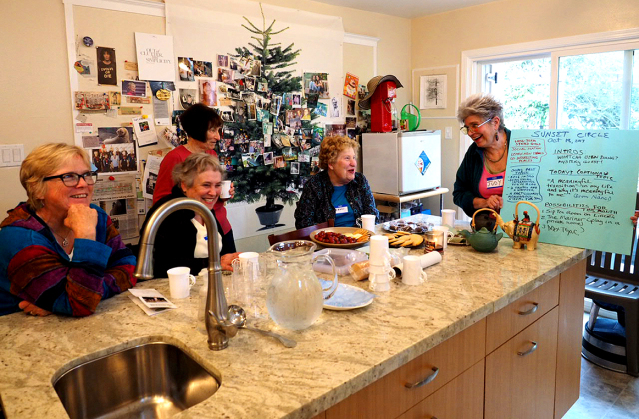Neighborhood Circles create community for San Francisco seniors

Most seniors, 87 percent, want to stay in their homes as they age, according to the American Association of Retired Persons. Fortunately for San Francisco seniors, the San Francisco Village’s “neighborhood circles” help them do that.
The nine-month-old Sunset Circle is one of 13 in San Francisco, including one for LGBT seniors, where neighbors meet regularly in a member’s home to share stories, exchange ideas and build rapport.
“The getting to know is exciting. You meet fascinating people. Not just the members, but also the volunteers,” said member Steve Hayashi, 73.
The circles are one aspect of the San Francisco Village program. Membership also includes access to a network of professional service providers as well as educational programs, group activities, intergenerational exchanges and volunteerism.
The idea of community collaboration to help seniors age at home was conceived in 2002 in Boston’s Beacon Hill neighborhood. The Boston model became a prototype for the “senior village” movement, which has spread across the country.
It takes a village
San Francisco Village was launched in the Richmond District in January, 2009 through the efforts of a group of community leaders, residents and health care experts.
The circles are an avenue for seniors to create activities specific to their own needs. All circles are initiated by member interest.
“We encourage members to take initiative to make things happen,” said Kate Hoepke, 62, who has been executive director since 2012.
Hayashi and his wife, Judy Bell-Wynn, 72, helped start a singing group once they discovered their passion was shared with other Sunset Circle members.
“We found a member who has a piano and another who is an experienced vocal coach. We have joyful sessions singing our hearts out,” Hayashi said.
Bell-Winn, “tugged by the sleeve,” helped Joan Walton, 80, start the Sunset Circle.
“There are two types of people – born leaders, the helper types, and others like me who need a little push to get involved,” she said. “It’s a collaborative effort.”
Sometimes it’s just ordinary things
Sometimes it’s as simple as finding people with whom to do ordinary things, like go to lunch or a play, Walton said.
San Francisco Village is a membership-driven organization. Dues are $600 yearly for an individual and $750 for a household, with a sliding scale for those who can not afford that amount. Dues provide up to 30 percent of the program’s funding, with fundraising (approximately 30 percent) and the Department of Aging and Adult Services (DAAS) making up the rest.
“We’re very proud that we can offer a price for everyone. Twenty percent of our members pay $100 a year,” Hoepke said. “Our goal is to bring as many people as possible into San Francisco Village. We don’t want dues to be an issue.”
San Francisco Village’s philosophy was inspired by Harvard Ph.D. Carol Gilligan’s work on ethical community and relationships, said Hoepke.
“Her ideas emphasize pro-social behavior along with traits such as honesty, fairness and respect,” she said.
Building barriers to ageism
Because “ageism permeates our culture,” according to Hoepke, the goal is to create positive experiences as a countermeasure.
“The hardest thing for people as they age is to ask for help. We want to make that easier,” she said.
Members have many ways to become integrated into the village community. They can join their neighborhood circle or check out other circles.
“Some people become ‘floaters’ and visit other neighborhoods when they find an interesting topic of conversation,” Winn-Bell said.
Walton said she really enjoyed the eight-week class on boosting your brain health.
“Classes like this keep me interested in life and happy,” Walton said.
Classes and workshops offered recently include The Origins of Civilization, Aging Well with Meditation and a Longevity Explorer Circle.
Mixing with the young
Members can also join outings, such as a Fort Mason walking tour, and snap up some free tickets to a number of Jewish Community Center of San Francisco (JCCSF) lectures.
Another important element of the village’s mission is to create inter-generational exchange. A mentoring program brings seniors and students together. In 2016, 75 ninth graders from City Arts & Technology High School met with 40 village members to gain insight into one another’s lives.
“We talk for an hour and a half once a quarter,” said Hayashi. “Sometimes the same kids return. It’s a great experience. They find out their elders are interested and interesting and we learn what’s important to them.”
The Sunset Circle, whose members range in age from 60 to 85, is creating a “karma bank,” said Bell-Winn.
“As we help others we realize that someday we will need help,” she said.
Village programs are managed by a paid staff of five and 175 volunteers, including some members. Volunteers, from high school students to seniors, provide transportation, shop for groceries, help with technology and more.
“I’m the tech geek,” said Hayashi.
In the Sunset, nearly one third of its 17,373 adults aged 60 and older live alone, according to the 2016 DAAS needs assessment.
Anyone interested in joining the Sunset Circle can call the San Francisco Village at (415) 387-1375 or go to the website at http://www.sfvillage.org.
There are regular classes and workshops at the new San Francisco Village offices at 3220 Fulton St., a welcoming, airy ground-floor space.





